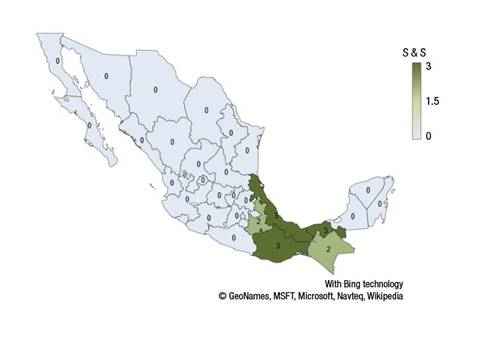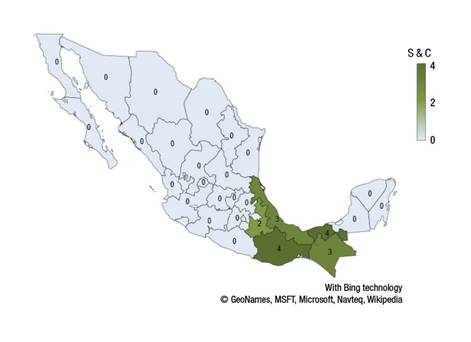Introduction
The behavior of current economic dynamics is characterized by the alternation of capital reproduction patterns and configures certain trends or cycles (Vargas-Canales, Palacios-Rangel, Aguilar-Ávila, & Ocampo-Ledesma, 2016). The importance of analyzing the cycles is that they are indicators of the economic situation of the countries (Tylecote, 1993), whose effect is linked to the conditions of others and generates chain reactions. Because of this, the productive structures of the countries have been transformed and have integrated very diverse economic agents (Vargas-Canales et al., 2016, 2018).
The trade and financial integration between countries allows observing a certain synchronization (movement in phase of the economic cycles of two or more countries) of their economic life, promoted by competitiveness (Mejía, Gutiérrez, & Farías, 2006). To adapt to highly competitive dynamics, it is necessary that the productive activities and technological innovations that best respond to economic cycles coincide with one another (Jimenez, 2014; Vargas-Canales et al., 2016).
The transformations and changes of the productive structures take place in the long term, which gives rise to specialization. The idea that the market is the principal driving force behind specialization dates back to Adam Smith (Smith, 1976). For Smith, competition in the market allows greater division of labor and specialization. Although this idea is an integral part of economic thought, it is surprising that there is almost no analysis of the market’s role in determining specialization (Emran & Shilpi, 2012).
International trade is essential and has effects in virtually all sectors, so positive effects on consumers, businesses, prices and consumption patterns can be observed (Martin, 2018); it also allows taking advantage of regional differences in resource endowments, capacities and skills, and consumers obtain a greater variety of better-quality products at lower prices. On the other hand, it is also argued that excessive dependence on external trade flows generates economic dependence, weakens sovereignty and puts food systems at risk (Fox & Castella, 2013; Ortíz, Montes, & Jiménez, 2016; Otero, Pechlaner, & Gürcan, 2013; Rubio, 2014)
Mexico has trade agreements with several countries, highlighted by the North American Free Trade Agreement (NAFTA), which has generated transformations in the country’s productive structure. Mejía et al. (2006) analyzed the synchronization of the economies of Mexico and the United States and found that it is not a generalized phenomenon; however, it is a shock mechanism that modifies the productive structure (Vargas-Canales et al., 2016) and, in general, stimulates regional specialization processes (Krugman, 1993). In this regard, one of the crops with potential and growing international demand is natural rubber (Hevea brasiliensis [Willd. ex A. Juss.] Müll. Arg.). The latex produced by this species accounts for more than 40 % of world consumption (de Souza et al., 2018; Montoro et al., 2018). With more than 10 million hectares, rubber cultivation and its industry play an important socio-economic role in rubber producing countries (Montoro et al., 2018); strong international demand has driven its expansion (Fox & Castella, 2013; Manivong & Cramb, 2008; Warren-Thomas, Dolman, & Edwards, 2015). World trade in natural rubber is estimated at 7.5 million tons per year and its importance as a cash crop continues to rise (Masson, Julien, & Boedt, 2013; Umar, Giroh, Agbonkpolor, & Mesike, 2011; Xiong, 2017).
The importance of natural rubber lies in its versatility as a raw material and input. The latex produced by the rubber tree has more than 40 000 uses (medical, industrial and cosmetic). Due to its unique properties such as resilience, efficient heat dispersion and malleability at high temperatures (van Beilen & Poirier, 2007), latex is considered a product virtually impossible to replace with petroleum derivatives and synthetic alternatives. At present, Asian countries account for 93 % of natural rubber production; however, southeastern Mexico has excellent natural conditions for its development (Vargas-Canales, Palacios-Rangel, Acevedo-Peralta, & Leos-Rodríguez, 2015) and proximity with one of the largest consumption centers (Rojo, Martínez, & Jasso, 2011).
Therefore, the hypothesis of this paper suggests that with NAFTA’s coming into effect in 1994, agricultural production in Mexico began a productive reconfiguration oriented towards regional specialization. Based on this, the objective of this work was to analyze the behavior of natural rubber production and identify highly specialized and competitive regions through regional analysis techniques in order to make proposals for the promotion of this crop.
Materials and methods
In this study, Mexico’s 32 federal states and their municipalities were considered fundamental geographical units to analyze the behavior of specialization and competitiveness of natural rubber-producing regions. The value of natural rubber production was taken as a study variable given the interest in defining the characteristics of its relative weight in the economies of the states and their municipalities. Production value information by state was obtained from the Agrifood and Fisheries Information Service (SIAP, 2018). It should be noted that the data correspond to commercial plantations, which is the characteristic natural rubber production system of Mexico. For this reason, because there is little cultural and ecological variability related to the crop, the data can be viewed as having a high reliability value.
With the information, a database was constructed of the value of rubber crop production from 1980 to 2016 for each state in relation to the agricultural sector (farming and livestock raising). Next, the location quotient (LQ) and Shift-Share were determined. In these analyses, the livestock and farming subsectors were considered as a single block and only the value of the product analyzed was excluded, in order to compare natural rubber cultivation with the total economy of the agricultural sector. The information was organized in a sector-region (SEC-REG) double-entry matrix, placing the agricultural sectors in columns and regions in rows (Boisier, 1980).
The following equation was used to calculate the LQ, where X is the analysis variable, i corresponds to the sector and j corresponds to the region (in this case, each federal state and the municipalities):
According to the LQ, it can be said that there is relative specialization of sector i in region j when its value is greater than 1 (Arias & Fortich, 2010; Boisier, 1980; Lira & Quiroga, 2003). The coefficient is interpreted as a measure of geographical concentration that locates the advantage of each sector within a conglomerate of regions. The closer LQ’s value to zero, the lower the sector’s degree of concentration in the region and vice versa. This implies that the more the economic structure of the state differs from that of the country as a whole, the greater its level of specialization (Gómez-Zaldívar, Mosqueda, & Duran, 2017; Mulligan & Schmidt, 2005).
For the calculation of Shift-Share, the following equations were used (Boisier, 1980):
where,
X |
analysis variable in time one, in sector i and region j |
Xijr |
total effect; the second |
|
analysis variable in time two |
S |
last sector of the total number of sectors analyzed |
R |
last region of the total geographic space analyzed |
Shift-Share analysis assesses the growth differential of the sectors analyzed in the regions studied. This is one of the most widely used dynamic analysis methods, by virtue of its analytical possibilities and the simple information necessary to construct it (Dunn, 1960). The method was proposed in the 1960s to determine which regions showed the greatest growth and whether it was attributed to: i) a global effect (sum of regions), ii) a sectoral effect (structural) or iii) a regional effect (competitive) (Camacho, Cervantes, Palacios, Cesín, & Ocampo, 2017). The sectoral effect expresses the positive or negative impact of growth in a specific sector, above or below the national growth rate. The regional or competitive effect captures the dynamism of a sector in a region, contrasting it with that same sector at the national level (Boisier, 1980; Camacho et al., 2017). In this sense, the indicators were integrated in order to better understand them (Table 1). Thus, for Shift-Share analysis, if a state has a positive effect in all three areas, then it has a maximum value of 3, and if they have a negative effect, the value is 0. Finally, to determine whether it is a specialized and competitive state, all the calculated indicators were integrated. It should be clarified that, in the case of the LQ, the positive or negative effect was determined according to its change for the analysis period (Table 1).
Table 1 Method of integrating indicators to determine specialization and competitiveness of natural rubber (Hevea brasiliensis) producing regions.
| Shift-Share | Specialization | Specialization and competitiveness | Value | ||
|---|---|---|---|---|---|
| National effect | Sectoral effect | Competitive effect | LQ(1980 - 2016) | ||
| - | - | - | - | - | 0 |
| + | - | - | - | + | 1 |
| + | + | - | - | ++ | 2 |
| + | + | + | - | +++ | 3 |
| + | + | + | + | ++++ | 4 |
Source: Author-made based on Arias and Fortich (2010), Boisier (1980), Camacho et al. (2017), Gómez-Zaldívar et al. (2017), Lira and Quiroga (2003) and Mulligan and Schmidt (2005).
Results
Location quotient
The LQ results show important changes in natural rubber production in the period analyzed. Figure 1 shows that, by 1980, production was concentrated only in the state of Veracruz. This indicates that rubber cultivation was of considerable importance to the state, with respect to the total of its agricultural economy.
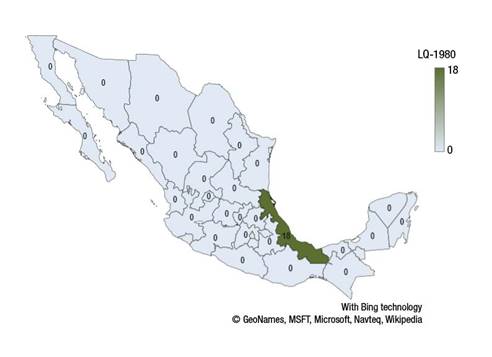
Figure 1 Location quotient (LQ) of natural rubber (Hevea brasiliensis) production in Mexico in 1980.
The crop’s diffusion is logical if one considers that in Veracruz the first experimental crops, sponsored by North American interests, were planted in the 1940s. However, it was not until the 1960s that the period of commercial plantations began (Rojo et al., 2011). Later, during the 1980s and 1990s, the crop expanded into Chiapas and Tabasco as part of the crop diversification initiative promoted by the Mexican Coffee Institute (INMECAFÉ) (Figure 2). The longitudinal analysis of the three temporal cuts shows that, over a little more than three decades, rubber cultivation expanded from the state of Veracruz to the states of Tabasco, Chiapas and Oaxaca. In the most recent period, the rubber economy advanced significantly in Oaxaca and Tabasco, with even the latter surpassing Veracruz in its level of rubber specialization (Figure 3).
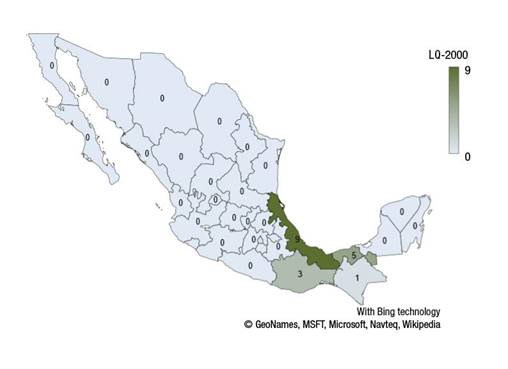
Figure 2 Location quotient (LQ) of natural rubber (Hevea brasiliensis) production in Mexico in 2000.
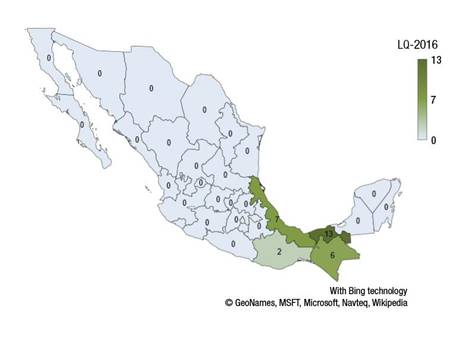
Figure 3 Location quotient (LQ) of natural rubber (Hevea brasiliensis) production in Mexico in 2016.
With respect to specialization at the municipal level, Table 2 shows a greater concentration of activity in a few municipalities, which make up the rubber-producing region that has the ideal environmental conditions for cultivation. In the state of Tabasco, Macuspana and Huimanguillo stand out; however, production could expand to the producing regions of the states of Veracruz, Chiapas and Campeche. In the case of the municipalities of Oaxaca, with high levels of rubber specialization, the LQ results are understandable since the municipalities are part of the poorest regions of the state and have predominantly agricultural economies and small-scale production systems. Thus, the weight of cash crops such as natural rubber is more significant.
Table 2 Location quotient of the natural rubber (Hevea brasiliensis) producing municipalities in Mexico (2016).
| State | Municipality | Location quotient |
|---|---|---|
| Tabasco | Macuspana | 16.20 |
| Huimanguillo | 5.90 | |
| Uxpanapa | 40.32 | |
| Hidalgotitlán | 37.25 | |
| Las Choapas | 27.23 | |
| Agua Dulce | 24.23 | |
| Moloacán | 19.42 | |
| Veracruz | Jesús Carranza | 15.95 |
| Santiago Sochiapan | 11.81 | |
| Playa Vicente | 7.86 | |
| Minatitlán | 5.63 | |
| Tezonapa | 4.20 | |
| Benemérito de Las Américas | 47.78 | |
| Palenque | 20.90 | |
| Chiapas | La Libertad | 5.04 |
| San Juan Bautista Valle Nacional | 249.40 | |
| San José Chiltepec | 157.14 | |
| Santa María Jacatepec | 137.78 | |
| San Juan Bautista Tuxtepec | 36.50 | |
| San Lucas Ojitlán | 36.33 | |
| Matías Romero Avendaño | 27.66 | |
| San Miguel Soyaltepec | 25.41 | |
| Oaxaca | Ayotzintepec | 24.76 |
| San Juan Lalana | 21.77 | |
| Acatlán de Pérez Figueroa | 17.26 | |
| Santiago Jocotepec | 14.68 | |
| San Juan Mazatlán | 11.41 | |
| Santiago Yaveo | 7.87 | |
| San Juan Cotzocón | 5.44 |
Shift-Share Analysis
According to Figure 4, the Shift-Share analysis results indicate that Veracruz, Oaxaca and Tabasco have competitive advantages in natural rubber production with respect to Mexico’s agricultural economy; that is, these states have a positive effect at the global (sum of regions), sectoral (structural) and regional (competitive) levels. On the other hand, it is important to emphasize that the expansion of natural rubber production places Chiapas and Puebla in a second level of competitiveness; for both cases, the regional effect has a negative behavior.
Specialization and competitiveness
With regard to the integrative analysis onto specialization and competitiveness, Figure 5 shows that Oaxaca and Tabasco have greater prospects for the growth of the crop and specialization of its productive structure and, therefore, for the increase and exploitation of its competitiveness characteristics. In this case, although Oaxaca has a low LQ, the analyses show a positive effect. This suggests that the state has ideal conditions for the promotion of the activity; that is, during the period analyzed there were particular situations in the region that favored the development of the crop. In a second level are Veracruz and Chiapas. However, Veracruz has a negative effect in terms of specialization, and Chiapas has a negative national effect; that is, the change in the regional economy of rubber production was negative. Finally, Puebla is ranked third with a specialization and negative national effect.
Discussion
Historically, there have been different stages of regional specialization of production systems; however, it is with the current globalization of economies that there has been greater development promoted by the policies of national governments, which facilitate conversion and productive specialization. It is important to mention that Mexican policy developed since the 1980s, and particularly in the mid-1990s, has had among its objectives to stimulate the concentration of the agricultural economy, thereby modifying traditional cultivation patterns in most cases (Ayala Garay et al., 2012; Sánchez, 2014).
In that sense, the main cause of the expansion of rubber crop production in Mexico has been the increase in national and international demand. According to the above and coinciding with Cruz-Delgado, Leos-Rodriguez, and Altamirano-Cárdenas (2013), production systems respond to market demand that was accentuated with the signing of NAFTA in 1994. As for the results obtained, they coincide with what was proposed by Warren-Thomas et al. (2015), who attribute the rapid growth and expansion of natural rubber cultivation to strong international demand. According to Masson et al. (2013), the importance of natural rubber as a cash crop has a positive trend. In addition, a shortfall in natural rubber production remains at the national and international levels, which will continue to drive its expansion given the characteristics of the product that make it irreplaceable in a wide variety of articles.
Unlike other domestic farming sectors, the country’s increased production has no direct correlation with trade flows that until 2018 formed NAFTA. In the case of rubber, U.S. market consumption seems to lean more towards synthetic rubber than natural rubber (Umar et al., 2011), which can be understood as a strategy of industrial policies to achieve less dependence on other geographical areas and as a way to take advantage of their petrochemical industry. In this sense, in our country, the impetus for growing specialization in regions with favorable conditions is largely due to domestic industry demand for rubber as a raw material or input. Some of these industries, such as the automotive one, are linked to NAFTA, so it can be said that by increasing their exports and thus their level of production, the effect on cultivation has been indirect.
Natural rubber production is concentrated in an area of southeastern Mexico where environmental conditions are ideal for cultivation, which gives Mexico a privileged position with respect to the main producing countries (Vargas-Canales et al., 2015); in addition, the relative proximity to one of the world's largest consumption centers, consisting of the United States and Canada (Rojo et al., 2011), represents another advantage. However, what is even more important is the domestic market itself, which has grown hand in hand with the development of certain industrial sectors, to such an extent that the importation of rubber from other latitudes has been necessary. From the perspective of the producers, the capitalization and profitability conditions of their rubber plantations could be better if the importation of cheap natural rubber was not so disproportionately favored in order to meet domestic industry demand.
The results also coincide with what was proposed by Ramírez-Jaramillo, Lozano-Contreras, and Cano-González (2018), who suggest that the country’s south-southeast region has a high potential of more than 1 million hectares to trigger the cultivation of rubber in the area, mainly in the states of Chiapas, Veracruz, Oaxaca, Tabasco and Puebla, where there are municipalities with optimal conditions for production. In addition, in recent years, wood obtained from rubber has increased its importance in all tropical regions because it is increasingly used for the manufacture of furniture, medium density fiberboard, particleboard, laminated veneer wood, plywood, cement wood board, and cellulose (corrugated paper), among others (Gómez, Domínguez, Martínez-Zurimendi, & Ramírez, 2018). This situation is a good alternative for the producer to obtain additional economic benefits. Likewise, the activity allows the development of a productive strategy that, in addition to being economically viable, is sustainable (van Beilen & Poirier, 2007), particularly in areas that show signs of disturbance as a result of anthropogenic action, a situation that has increased due to changes in land use from forestry to farming or livestock raising, and immoderate logging and forest fires, among other factors (Salazar, Zavala, Castillo, & Cámara, 2004). On the other hand, rubber cultivation allows agroforestry management with great capacity for carbon capture, provides environmental services and helps conserve the flora and fauna associated with this system (López-Reyes et al., 2016; Warren-Thomas et al., 2015).
In recent years, historical dependence on rubber imports has reached levels above 90 %; that is, domestic production has not been able to cover even 10 % of industry needs. This occurs despite the fact that the Mexican humid tropics have the ideal conditions and potential to establish the crop; currently, the area covered is approximately 26 000 ha, while Guatemala has triple the area and its latex is almost entirely sent to the Mexican market. In this sense, according to the results, Tabasco and Oaxaca have comparative advantages over other producing states in Mexico. In the case of Oaxaca, it is worth mentioning that rubber is expanding in regions where small-scale farming predominates, hence the product provided by the cultivation of rubber has a very high weight.
On the other hand, according to Álvarez-López, Perales, and Trujillo (2014), the Mexican forestry sector has concentrated on conifer extraction; however, changes have been observed in recent years, with greater attention being paid to broadleaf and tropical species. In general, forest production has declined, so that imports have greater dynamism, which is reflected in greater dependence on products and by-products from other countries. Among the main factors are the exchange rate and the sub-sector’s lack of competitiveness caused by technical, administrative-fiscal and infrastructure and investment factors.
Considering the above and the current scenario of great trade openness, it is necessary, on the one hand, to develop a great capacity for adaptation of all productive sectors and, especially, of those with greater links with international markets. On the other hand, in order to be more efficient and competitive, it is essential to evolve towards the specialization of production systems (Billen, Le Noë, & Garnier, 2018; Bustamante, Vargas, Carrera, & Rodríguez, 2019). In this context, it is desirable to strengthen technological development that allows greater productive efficiency; that is, to develop innovations for the rubber production systems that are the ones that actually compete at the national and international level, which is why it is necessary to improve the agronomic handling and collection and processing of rubber. Generally speaking, the rubber industry in Mexico is practically non-existent and the existing one is obsolete and abandoned.
In synthesis, the production of natural rubber in Mexico represents a good option for the development of the sector, given that it has the ideal conditions to compete successfully in the international market and, even more, to supply the demand of domestic industry to a considerable extent. In addition, the establishment of rubber plantations has several advantages and positive externalities, highlighted by the following: 1) great capacity for carbon capture and generation of environmental services, as they help conserve the flora and fauna associated with these agroforestry systems; 2) from the social point of view, it generates a high demand for labor during all phases of cultivation, from the establishment of nurseries to the establishment and maintenance of plantations. In this sense, promoting the development of a regional innovation system (Asheim, 2018) for rubber production represents a dynamic perspective on innovation and learning in the promotion of competitiveness and economic growth; it is also a fundamental policy tool for the design and implementation of smart specialization strategies.
Conclusions
Natural rubber production shows significant expansion and reconfiguration of its specialization. The transformation of the productive structure is related to the natural conditions of the regions, unmet market demand and technological development. The states with the greatest prospects for growth and being highly specialized and competitive are Oaxaca and Tabasco, so it would be expected that natural rubber production systems will expand to these regions that in theory should be the most productive and with the lowest production costs. To achieve competitive rubber production, it is necessary to improve all the links in the value chain. This is possible if a regional innovation system is promoted for the design and implementation of smart specialization strategies. This information is useful in facilitating and guiding agricultural policy makers in decision-making. Finally, for future research it would be advisable to analyze the sustainability of these production systems.











 texto en
texto en 

